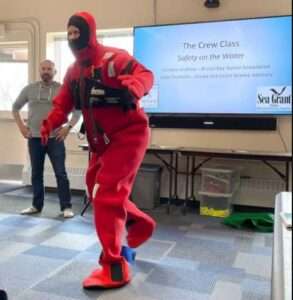
Bristol Bay, on Alaska’s remote western coast, is the most productive salmon ecosystem in North America and home to a multi-billion-dollar fishery. To meet the needs of the Bristol Bay commercial fishing industry for a skilled, healthy, and productive workforce, Alaska Sea Grant offers a combined training that incorporates established safety best-practices with essential fishing crew job skills for new and experienced workers. The training, most recently held in May, is conducted in the Bristol Bay region in order to be accessible to the local workforce.
Last year, 2022, proved to be remarkable for safety in Alaska commercial fisheries. It was only the second time that Alaska has had a fatality-free commercial fishing season, the other being in 2015. This follows a positive state trend in fishing accident reduction, due in large part to the efforts of the state’s marine safety organizations and instructors. One such organization, the Alaska Marine Safety Education Association (AMSEA), has been leading the charge to improve safe fishing practices throughout Alaska for nearly 40 years. Their onboard drill conductor training course addresses cold water survival, immersion suit use and maintenance, damage control guidance, and many more safety practices specific to Alaska’s harsh conditions.

Alaska Sea Grant has added job-skills training specifically for the Bristol Bay salmon gillnet fishery. The combined AMSEA/Crew Class teaches knot tying, net hanging and mending, fish picking techniques, boat handling, and international rules for preventing collisions at sea, in conjunction with the world-class accredited AMSEA safety training program.
While the class is designed for relatively new commercial fishers, it can also help those with many years of experience. One participant who had been fishing for over 10 years reported learning for the first time the correct technique for tying a bowline.
Last month’s class in Dillingham was led by Tav Ammu, the Alaska Sea Grant Marine Advisory Program agent in Bristol Bay, with assistance from Marine Advisory Program fisheries specialist Gabe Dunham, and Kristina Andrew, the Bristol Bay Native Association economic development program manager. In addition, a half-dozen invited local skippers provided advice and answered trainees’ questions during a lunch session.
Students practiced emergency response to simulated life-threatening situations aboard commercial fishing vessels in Bristol Bay. After first donning immersion suits in the safe and structured atmosphere of the classroom, students went to the Dillingham boat harbor to get a literally immersive experience. In another skills session, after learning about emergency signals used in a survival situation, students went to the harbor and practiced lighting signal flares.
“Creating a realistic but safe atmosphere allows students to prepare for emergencies without being overwhelmed,” said Dunham. “The focus of the class is to keep onboard safety front-and-center by teaching both new and experienced fishers safe and efficient skills for the upcoming fishing season.”
Reported trainee Casey Chandler, “After taking the AMSEA/Crew Class, I feel more prepared and confident to be a crew member this summer.”
If you are interested in future AMSEA/Crew Class offerings, contact Tav Ammu.
